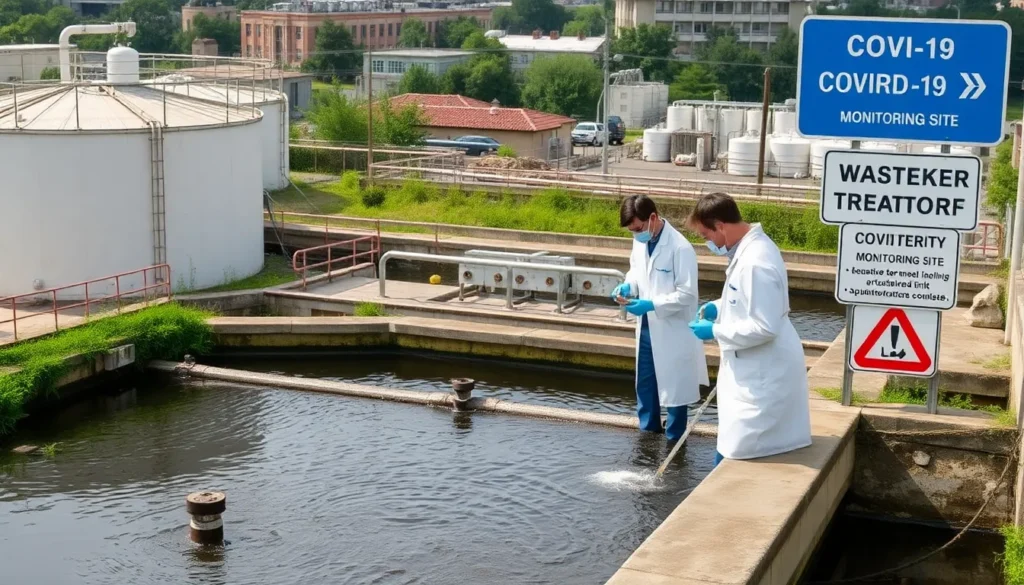Table of Contents
ToggleAs the world continues to navigate the unpredictable waters of the COVID-19 pandemic, scientists have turned to an unlikely hero in the fight against the virus: wastewater. Yes, you heard that right! Those murky waters beneath our feet are now providing crucial insights into the spread of the virus across various states. Who knew that the stuff we flush away could be a treasure trove of information?
Overview of COVID Wastewater Monitoring
COVID wastewater monitoring serves as a crucial tool for understanding the spread of the virus. Researchers analyze samples from wastewater treatment facilities, providing real-time insight into infection levels within communities. This method detects traces of the virus even before clinical cases emerge.
The utility of wastewater monitoring lies in its ability to cover large populations without extensive testing. States with higher concentrations of COVID-19 can be identified through this analysis. Patterns in wastewater data often correlate with spikes in hospitalizations and reported cases.
Monitoring occurs regularly, with many states employing advanced technology to streamline the process. Samples undergo rigorous testing for viral RNA, revealing trends in transmission. Data from these tests often guides public health decisions, such as vaccine distribution and localized interventions.
Several states, including California, Texas, and Florida, lead in wastewater monitoring efforts. They integrate findings with traditional epidemiological data to form a comprehensive view of community health. By focusing on this method, experts can shift strategies preemptively, addressing potential outbreaks before they escalate.
Data shows that wastewater surveillance may detect changes in virus prevalence weeks ahead of clinical reports. This early warning system can reduce transmission rates and increase public health responses’ effectiveness. Communities benefit from timely updates on infection levels, fostering informed public health practices.
States With High COVID Wastewater Levels

Analysis of wastewater has emerged as a vital tool for assessing COVID-19 levels across various states. Several states experience high concentrations of COVID in their wastewater, which correlates with community transmission rates.
Impact on Public Health
High COVID wastewater levels indicate rising infection rates within communities. States with alarming wastewater data prompt public health officials to enhance monitoring efforts. Decision-makers rely on this information to inform strategies such as vaccination drives and targeted interventions. Certain regions, especially those showing significant spikes, may implement stricter guidelines to curb transmission. Proactive measures derived from wastewater analysis lead to better resource allocation and timely public health responses.
Identifying Trends Over Time
Tracking COVID levels through wastewater allows for the identification of trends over time. Continuous monitoring reveals fluctuations in virus prevalence, offering insights into emerging outbreaks. States that observe consistent increases often prepare for potential surges in clinical cases and hospitalizations. By comparing past data with current findings, researchers can discern patterns and anticipate future developments. Effective trend analysis fosters a better understanding of community health dynamics and enhances preparedness in response efforts.
Analysis of Contributing Factors
Various elements contribute to high COVID wastewater levels in specific states. These factors provide insight into the dynamics of virus transmission within communities.
Population Density
Higher population density directly correlates with increased COVID wastewater levels. Urban areas house more people, facilitating faster virus spread. Increased interactions among residents lead to higher infection rates. States like California and New York experience this phenomenon, where densely populated cities show significant wastewater traces. Public health responses often reflect population density, prompting targeted interventions in these regions. Monitoring wastewater in high-density areas helps identify emerging outbreaks early. Consequently, states can implement strategies to mitigate virus transmission effectively.
Variants and Strain Prevalence
Variants and strain prevalence impact COVID wastewater concentrations significantly. Different strains exhibit varying infectivity levels, influencing community transmission rates. For instance, the Delta and Omicron variants have shown increased transmissibility, leading to surges in wastewater data. States reporting higher levels often deal with these more contagious strains. Continuous sequencing of variants enables public health officials to adjust strategies promptly. By analyzing wastewater, they can detect variant prevalence before clinical reported cases rise. Thus, understanding strain dynamics allows for better preparation and reaction to changing COVID landscapes.
Mitigation Strategies Employed
States with high COVID wastewater levels deploy various mitigation strategies to control the virus spread. Enhanced monitoring efforts play a crucial role in detecting rising infection rates early. Public health officials concentrate on communities exhibiting significant wastewater traces, implementing targeted interventions to reduce transmission.
Vaccination drives frequently target areas marked by high virus concentrations. For example, states such as California and Florida prioritize these regions to ensure timely access to vaccines. Stricter guidelines are often imposed in hotspots, as officials assess data from wastewater analysis to inform decisions quickly.
Communities also benefit from public awareness campaigns that educate residents about the importance of following health guidelines. Regular updates based on real-time data help maintain vigilance and encourage compliance. Many states collaborate with researchers and health departments to analyze trends within wastewater surveillance, allowing them to adjust strategies effectively.
Behavioral modifications, such as mask mandates and social distancing, get enforced in response to escalating virus levels. Localized restrictions aim to curb transmission, particularly in densely populated areas that display alarming wastewater data. In addition, officials track COVID variants through continuous sequencing, which informs rapid responses to changing dynamics.
Timely interventions based on wastewater insights result in more effective community health management. As patterns within wastewater evolve, so do the tactics to safeguard public health. The commitment to integrating wastewater monitoring with traditional epidemiological data enhances collective preparedness and response efforts against COVID-19.
Monitoring COVID-19 through wastewater provides a proactive approach to understanding and managing the virus’s spread. States with high levels of COVID wastewater can implement timely interventions and targeted strategies to protect community health. This innovative method not only reveals trends in virus prevalence but also serves as an early warning system for potential surges in infections. By integrating wastewater data with traditional epidemiological practices, public health officials can make informed decisions that enhance overall preparedness and response efforts. As the pandemic evolves, wastewater surveillance will remain a critical tool in navigating public health challenges.







